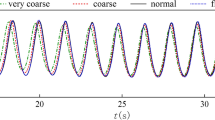Abstract
A theoretical approach is derived to study interaction of linear water waves with an air bubble curtain used as a pneumatic breakwater. Modelling of wave transmission through an aerial barrier is a complex task due to a need to cover processes associated with wave-current interaction, effects of two-phase flows, wave damping, etc.. An initial boundary-value problem is solved by applying an efficient eigenfunction expansion method and a time-stepping procedure. The derived semi-analytical solution is used to study the effect of basic parameters of the model on wave dissipative properties of the pneumatic breakwater. Results show that wave damping by the breakwater is mainly affected by an air flow rate. The increased air discharge results in higher velocities of ascending bubbles and increases aerial barrier width. This leads to a substantial reduction of transmitted wave heights, especially for waves of intermediate length and short waves. In order to verify the applicability of the presented theoretical approach, laboratory experiments are conducted in a wave flume for different wave regimes and pneumatic breakwater characteristics. The analysis of a wave transmission coefficient calculated numerically and measured in the laboratory confirms that the derived model can be used for a certain range of wave conditions.
Similar content being viewed by others
References
Wang Y., Wang G., Li G. Investigation on model law of air bubbles breakwater, Hydrodynamics VI: Theory and applications [M]. Boca Raton, USA: Taylor and Francis, 2004, 319–324.
Iwagaki Y., Asano J., Honda T. Combination effect of pneumatic breakwater and other type breakwater on wave damping [C]. Proceedings of the 16th International Conference on Coastal Engineering. Hamburg, Germany, 1978, 2172–2190.
Evans J. T. Pneumatic and similar breakwaters [J]. Proceedings of the Royal Society A, 1955, 231(1187): 457–466.
Carr J. H. Mobile breakwater studies [R]. Pasadena, USA: California Institute of Technology, Hydrodynamics Laboratory, Report No. N-6U.2., 1950.
Taylor G. I. The action of a surface current used as a breakwater[J]. Proceedings of the Royal Society A, 1955, 231(1187): 466–478.
Hensen W. Laboratory investigations on pneumatic breakwater [J]. Mitteilungen der Hannover’schen Versuchsanstalt fuer Grundbau und Wasserbau, 1955, 179–214 (in German).
Hensen W. Experimental study on pneumatic breakwater in laboratory and field conditions [J]. Mitteilungen der Hannover’schen Versuchsanstalt fuer Grundbau und Wasserbau, 1957, 183–209 (in German).
Preissler G. Wave dumping through compressed air [J]. Wasserwirtschaft-Wassertechnik, 1960, 11: 514–519 (in German).
Bulson P. S. The theory and design of bubble breakwaters [C]. Proceedings of the 11th International Conference on Coastal Engineering, ASCE. London, UK, 1968, 995–1015.
Brevik I. Partial wave damping in pneumatic breakwaters [J]. Journal of the Hydraulics Division, 1976, 102(9): 1167–1176.
Longuet-Higgins M. S., Stewart R. W. The changes in amplitude of short gravity waves on steady non-uniform currents [J]. Journal of Fluid Mechanics,1961, 10: 529–549.
Zhang C., Wang C. Y., Wang C. G. et al. Wave dissipating performance of air bubble breakwaters with different layouts [J]. Journal of Hydrodynamics, 2010, 22(5): 671–680.
Sulisz W., McDougal W. G., Sollitt C. K. Wave interaction with rubble toe protection [J]. Ocean Engineering, 1989, 16(5-6): 463–473.
Sulisz W. Diffraction of nonlinear waves by horizontal rectangular cylinder founded on low rubble base [J]. Applied Ocean Research, 2002, 24(4): 235–245.
Sulisz W. Wave propagation in channel with side porous caves [J]. Journal of Waterway, Port, Coastal, and Ocean Engineering, 2005, 131(4): 162–170.
Sollitt C. K., Cross R. H. Wave transmission through permeable breakwaters [C]. Proceedings of the 13th International Conference on Coastal Engineering, ASCE. Vancouver, Canada, 1972, 1827–1846
Sulisz W. Wave reflection and transmission at permeable breakwaters of arbitrary cross section [J]. Coastal Engineering, 1985, 9(4): 371–386.
Fenton J. D. Numerical methods for nonlinear waves (Liu P. L.-F. Advances in Coastal and Ocean Engineering) [M]. Singapore: World Scientific, 1999, 5: 241–324.
Sulisz W., Paprota M. Modeling of the propagation of transient waves of moderate steepness [J]. Applied Ocean Research, 2004, 26(3): 137–146.
Sulisz W., Paprota M. Modeling of the propagation and evolution of nonlinear waves in a wave train [J]. Archives of Mechanics, 2011, 63(3): 311–335.
Sulisz W., Paprota M. Generation and propagation of transient nonlinear waves in a wave flume [J]. Coastal Engineering, 2008, 55(4): 277–287.
Sulisz W., Paprota M. Modeling of the propagation and transformation of transient nonlinear waves on a current [J]. China Ocean Engineering, 2013, 27(5): 579–572.
Press W. H., Flannery B., Teukolsky S. A. et al. Numerical recipes [M]. Cambridge, UK: Cambridge University Press, 1988.
Paprota M. PIV Measurements of air bubble breakwater kinematics [C]. Proceedings of the 3rd IAHR Europe Congress, IAHR. Porto, Portugal, 2014.
Brevik I. The flow in and around air-bubble plumes [J]. International Journal of Multiphase Flow, 2002, 28(4): 617–634.
Liang N. A reflection of pneumatic breakwater [J]. Journal of Coastal and Ocean Engineering, 2006, 6(1): 85–99.
Peregrine D. H. Interaction of water waves and currents [J]. Advances in Applied Mechanics, 1976, 16: 9–117.
Paprota M. Laboratory investigations of wave transmission through a submerged aerial barrier [C]. Proceedings of the 6th International Short Course/Conference on Applied Coastal Research. Lisbon, Portugal, 2013.
Author information
Authors and Affiliations
Corresponding author
Additional information
Biography: Maciej Paprota (1978-), Male, Ph. D.
Rights and permissions
About this article
Cite this article
Paprota, M., Sulisz, W. Modelling of wave transmission through a pneumatic breakwater. J Hydrodyn 29, 283–292 (2017). https://doi.org/10.1016/S1001-6058(16)60738-2
Received:
Revised:
Published:
Issue Date:
DOI: https://doi.org/10.1016/S1001-6058(16)60738-2




